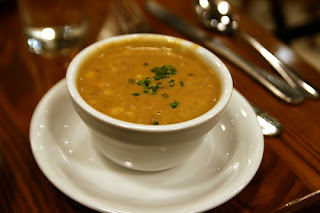from
Behind the French Menu
by
Bryan G. Newman
behindthefrenchmenu@gmail.com
Clam Chowder
Chowder was created in France, not Boston and then it was a fisherman's and fisherwoman's stew made with any unsold or unpopular shellfish; unsold sea fish would usually be taken home for the family. At the end of a 12 hour plus work day, this would have been the fishermen’s and fisherwomen’s’ first meal. Today chowder, in a French seafood restaurant will be made with the very best seafood and or sea fish.
A shrimp and corn chowder
Chaudrée or Chaudière - Fish and seafood chowders are rich, velvety soups or thick stews. Nearly all French chowders include white wine, garlic, potatoes, and herbs, and many include crème fraîche and or butter.
Chowder on the French menus:
Chaudrée de Moules au Vin Blanc et Fleur d'Ail – A mussel chowder made with white wine and flavored with the crushed stems and buds of garlic flowers. (Garlic flowers are, as a rule, much lighter tasting than regular garlic; but I was warned that while the wild garlic flower is beautiful do not bring them into the house for decoration!).
Chaudrée de Palourdes et Croûtons à l'Ail. – Clam chowder with garlic flavored croutons. When clam chowder is on the menu, it is rare that you will see the name of a particular clam, and most modern French clam chowders also include mussels. French clam chowders may also include the North American Quahog, called the Cherry Stone Clam in the USA. The original American Indian name for the Cherry Stone Clam was quahogs, and these clams were introduced accidentally into Europe some 80 years ago from the USA. This clam is added for its texture with other clams providing the taste. The cherry stone clam in France is called the Palourde Américaine or Palourde Quahog Nordique, or Le Clam. This is a relatively large clam, from 5 -10 cm (2" - 4") across.
Cherry Stone Clams
Chaudrée de Pétoncles au Maïs Rôti - Scallop chowder prepared with roast corn, that’s roast maize in the USA.
Chaudrée de Poissons - Fish Chowder. When this is all the information on the menu it is time to ask which fish is in the chowder!
Chaudrée de Poissons et Fruits de Mer, Pommes de Terre Salardaises. A fish and seafood chowder served with a side dish of Pommes de Terre Salardaise. Pommes de Terre Salardaise are potatoes baked in duck fat and flavored with garlic and parsley; a traditional recipe from the Dordogne.
A seafood chowder.
Chaudrée de Saumon et de Crevettes aux Pommes De Terre – A salmon and shrimp chowder served with potatoes.
Chaudrée Vendéenne - A traditional fish and seafood chowder from the department of Vendée in the region of the Pays de la Loire; in fact, this is really a stew. A Chaudrée Vendéenne will include anguille, eel; congre, conger eel; seiche, cuttlefish; white wine, butter, onions, shallots, garlic, and fennel.
Chowder served in a bread bowl.
A classic and attractive way to serve a chowder.
It is easy to see how the French word Chaudrée, became chowder in English; with the 1066 invasion of England by William the Conqueror, many French words entered the English kitchen. Another French word occasionally used for chowder is Choudiere; a Choudiere was the pot or cauldron in which the fisherman would cook their chowder at the end of a long work day. Today’s chefs do not fish for a living and they will be using far better fish and seafood than those who originally cooked with a Choudiere.
With a few notable exceptions, most of the mainland French clam offerings are only seen on the French side of the Atlantic and in the Mediterranean. On a seafood restaurant menu, quite a number of words may be used to indicate clams; the most usual and correct name is Palourde; however, the menu may also use traditional names including, but not only: Clam, Praires, Venus, Vernis, and Clovis. With a few exceptions, the clams from North America's Atlantic coast are not seen in Europe.
Abalone, the Ormeau or Oreille-de-Mer.
In clam chowders, in France as elsewhere around the world, chefs may include the meat of the abalone, also called the sea ear; and that despite the abalone not being a clam. Nevertheless, clams and abalones are closely related with similar textures. The abalone is large to very large sea snail with good meat and a slightly sweet taste and a texture that blends in well. While the abalone may be found in many French restaurant kitchens, it will rarely be noted by name on the menu. Nevertheless, Abalone meat is often part of shellfish salads; in French, the abalone is the Ormeau or Oreille-de-mer.
The shell of an Abalone.
Abalone shells have attractive colors and are often used in jewelry.
Connected Posts:
Behind the French Menu
by
Bryan G. Newman
behindthefrenchmenu@gmail.com
Copyright 2010, 2011, 2016













